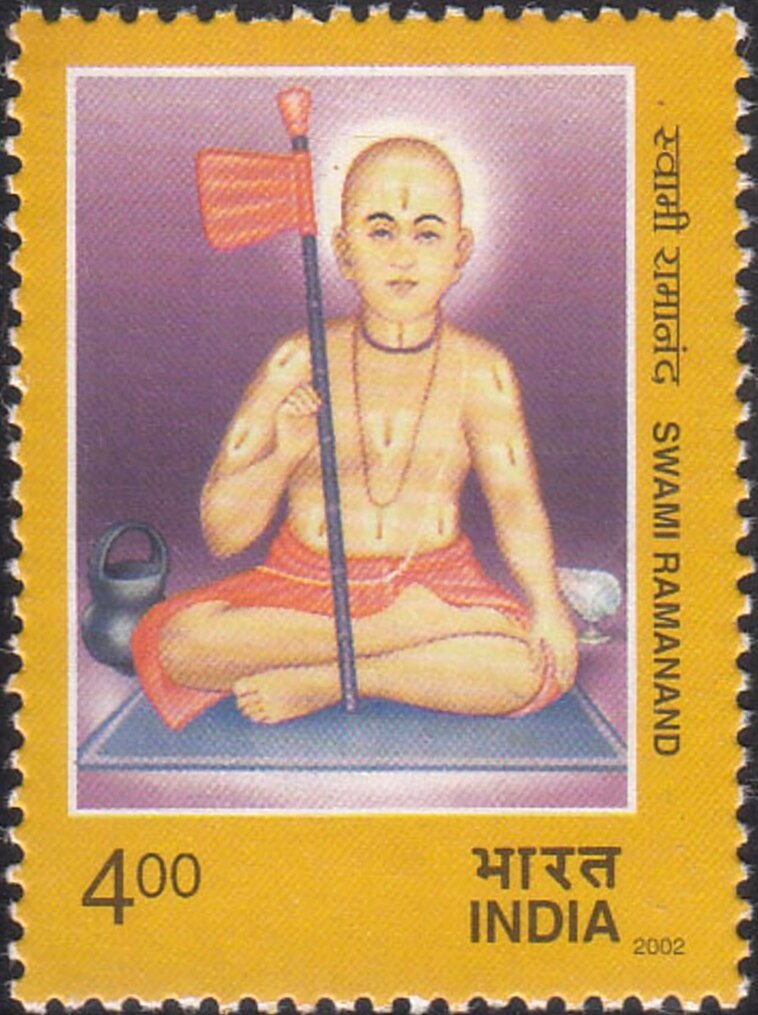Swami Ramanand (1795-1858)

Technical Data
| Date of Issue | February 4, 2002 |
|---|---|
| Denomination | Rs. 4 |
| Quantity | 400,000 |
| Perforation | comb 13¼ x 13½ |
| Printer | Eagle Press Ltd. |
| Watermark | No Watermark |
| Colors | Multicolor |
| Catalog Codes |
Michel IN 1896 Stamp Number IN 1949 Yvert et Tellier IN 1661 Stanley Gibbons IN 2061 WADP Numbering System - WNS IN008.02 |
| Themes | Commemoration | Famous people | Men | Religion |
Table of Contents
Commemorative Stamp Set: Swami Ramanand
Design Elements:
The stamp design for Swami Ramanand would feature a portrait of the revered saint, depicted with a serene and contemplative expression. The background might include elements related to his life and teachings, such as the sacred city of Kashi (Varanasi), where his memorial stands. Visual elements could also include symbols of the Bhakti Movement, like the Vaishnavaite icons and the imagery of the lower castes finding dignity. The design could be embellished with motifs representing unity and equality, reflecting Swami Ramanand’s teachings on social harmony.
Cultural and Historical Significance:
Swami Ramanand was a pivotal figure in the Bhakti Movement, which was a significant socio-religious renaissance in medieval India. His teachings challenged the rigid caste system and emphasized the equality of all individuals before God. By advocating that divine worship is accessible to everyone regardless of caste or social status, he played a crucial role in reforming religious practices and promoting social justice. His influence extended beyond religion, impacting social reforms and inspiring various saints and reformers who carried forward his message of equality and devotion.
Usage:
The commemorative stamp would be used to honor Swami Ramanand’s contributions to religion and social reform. It can be used in philatelic collections and as a part of educational and commemorative materials to raise awareness about his life and teachings. The stamp could also be used in correspondence to highlight the importance of his message and promote the values he championed.
Importance of the Commemorative Stamp Set:
This stamp set underscores the significance of Swami Ramanand’s role in shaping the Bhakti Movement and his impact on both religious and social spheres. By commemorating his contributions, the stamp aims to educate the public about his revolutionary ideas and their lasting influence on Indian society. It also helps preserve and celebrate the heritage of the Bhakti Movement and its key figures.
Example of the Stamp Design:
The design might feature a portrait of Swami Ramanand with a backdrop of Kashi’s architectural elements. Surrounding the portrait could be symbols of the Bhakti Movement and the sacred texts that reflect his teachings. The design would include inscriptions highlighting his key contributions and the values he promoted, such as equality and devotion.
The commemorative stamp set might include:
- Portrait of Swami Ramanand – Centerpiece of the stamp, reflecting his serene and spiritual demeanor.
- Kashi Background – Depicting the sacred city of Varanasi, associated with his life and memorial.
- Symbols of Bhakti Movement – Icons representing the inclusive and devotional aspects of his teachings.
- Quotes and Inscriptions – Key messages and teachings of Swami Ramanand, emphasizing his revolutionary ideas on social equality and divine worship.
Significance:
The Swami Ramanand stamp set celebrates a key figure in the Bhakti Movement who challenged social norms and advocated for equality and spiritual access for all. His teachings continue to inspire and resonate across communities, and the issuance of this stamp is a tribute to his enduring legacy in promoting religious tolerance, social reform, and the upliftment of marginalized communities.
